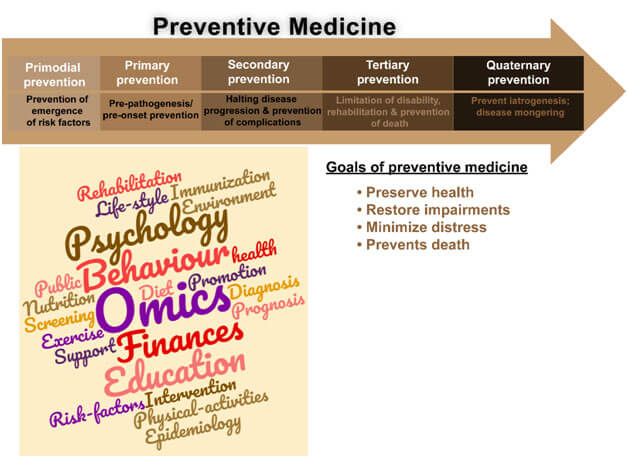Definition and 5 Levels of preventive health care / preventive medicine
Prevention is defined as “Actions that prevent disease occurrence. Efforts aimed at eradicating, eliminating, or minimizing the impact of sickness and disability, or if none of these is feasible, retarding the progress of disease and disability, reducing or minimizing”[1].
Preventive Medicine: “The distinctive aspects of preventive medicine include knowledge of and competence in biostatistics; epidemiology; administration, including planning, organization, management, financing, and evaluation of health programs; environmental health; application of social and behavioral factors in health and disease; and the use of primary, secondary, and tertiary prevention measures within clinical medicine”[1].
Leavell and Clark´s Levels of Prevention show three basic levels of prevention, Primary Prevention, Secondary Prevention, Tertiary Prevention[2]. Later on ‘Primordial Prevention’ and Quaternary prevention came into play.
To identify themes associated with preventive medicine, first, the definition and goals of prevention have been designated as shown above. Then, Pubmed and Google Scholar were searched for terms ‘preventive medicine’ ‘Primordial Prevention,’ Primary Prevention, Secondary Prevention, Tertiary Prevention and Quaternary prevention. The major themes discussed in these publications were noted down in Table 1. Then the table was submitted to a word cloud generator to generate a word cloud which represents the most prominent themes in preventive medicine.
| Recommended for you | |
| 13 Themes of preventive medicine | |
| Convergence of preventive health care | |
| Preventive medicine in the omics era |
Table I. Identification of themes associated with levels of preventive medicine
| Primordial Prevention | Primary Prevention | Secondary Prevention | Tertiary Prevention | Quaternary prevention |
|---|---|---|---|---|
| Identification of risk factors and groups | Reduce the incidence of disease | Increase survival | Reduce impairment | Actions that prevent iatrogenesis and “disease mongering |
| Epidemiology | Environment | Diagnosis | Rehabilitation | Public-policies |
| Omics | Nutrition | Omics | Psychology | Finances |
| Public-policies | Immunization | Prognosis | Physical-activities | |
| Risk-factors | Public health | Screening | Pharmacology | |
| Education | Promotion | Psychology | Omics | |
| Finances | Public-policies | Behaviour | Support | |
| Education | Intervention | |||
| Behaviour | Pharmacology | |||
| Life-style | Diet | |||
| Exercise | ||||
| Pharmacology |
Figure 1. Levels, objectives and different themes of preventive medicine

The upper panel illustrates five levels of preventive medicine, defined based on the progression of the disease. The lower panel shows a word cloud designed based on the themes represented under each level of prevention.
Image credit: www.istockphoto.com

















